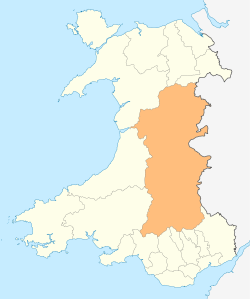Sarn Helen
Coordinates: 53°16′55″N 3°49′41″W / 53.282°N 3.828°W

Sarn Helen refers to several stretches of Roman road in Wales. The 160 mi (260 km) route, which follows a meandering course through central Wales, connects Aberconwy in the north with Carmarthen in the west.[1] Despite its length, academic debate continues as to the precise course of the Roman road. Many sections are now used by the modern road network while other parts are still traceable. However, there are sizeable stretches that have been lost and are unidentifiable.
The route is named after Saint Elen of Caernarfon, a Celtic saint, whose story is told in The Dream of Macsen Wledig, part of the Mabinogion. She is said to have ordered the construction of roads in Wales during the late 4th century.
Route
Aberconwy–Carmarthen
In the north the route is believed to follow the western bank of the river Conwy from Canovium, a fort at Caerhun, passing through Trefriw, then leading on to Betws-y-Coed, with a branch leading to Caer Llugwy near Capel Curig. The route then passed through Dolwyddelan, running up the Cwm Penamnen valley and past the higher parts of Cwm Penmachno. The route then leads on past Llan Ffestiniog to the Roman fort of Tomen y Mur, near Trawsfynydd before continuing south towards Dolgellau.
South of Dolgellau the route passes over Waen Llefenni into Cwm yr Hengae to Aberllefenni. Part of the narrow-gauge Corris Railway between Aberllefenni and Maespoeth Junction may run along the line of the Sarn,[2] and the modern A487 trunk road between Corris and the Afon Dyfi may follow its route. It probably crossed the Dyfi by a ford or ferry near the Roman fort at Pennal.
In Ceredigion Sarn Helen runs as part of a B-road in Bronant, and six miles south there is a long stretch through the hamlet of Stag's Head. It passes down to Llanio, where there was a small Roman fort named Bremia, and crosses over to Dolaucothi before reaching Llandovery. The route survives as a minor road here, although severely affected by potholes where it crosses the mountains.
Neath–Brecon
A further section of Roman road leading north-eastwards from Neath (Nidum) to Banwen at the southern edge of the Brecon Beacons National Park is also known as Sarn Helen. It continues north-eastwards through the park to the north-west of Ystradfellte, beneath Fan Frynych, and then across Mynydd Illtud en route to the Roman fort of Y Gaer, Brecon (Cicucium).
Outdoor pursuits
Cycle route
A long-distance mountain bike route named the Sarn Helen Trail follows parts of the road's course.[3] The 270 mi (430 km) trail, which was devised in 1996, runs between Conwy on the North Wales coast and Worms Head on the Gower Peninsula.[4]
Fell running
The road gives its name to the annual Sarn Helen Hill Race that starts and finishes in Lampeter in mid Wales. The 16.5-mile (26.6 km) multi-terrain race, which was founded in 1980, takes place in May each year. It claims to combine "the speed of road racing with the rigours of cross country and fell running over a challenging picturesque course".[5]
In popular culture
"Sarn Helen" is also the title of a song by Welsh band Super Furry Animals, named after the Roman road, appearing on their Welsh language album Mwng.
"Sarn Helen" is also the title of a 1997 sequence of poems by English poet John Wilkinson, named after the Roman road.
Notes
Citations
- ↑ 51°51′22″N 4°18′40″W / 51.856°N 4.311°W
- ↑ Corris Railway Society Journal 2002
- ↑ Sarn Helen Trail (MBRUK website)
- ↑ Woodcock, Tim (1999). The Coast-to-coast Mountain Bike Route Pack. Mountain Bike Routes UK. ISBN 1902891007.
- ↑ "Sarn Helen Hill Race". Clwb Sarn Helen Club. Retrieved 2 June 2014.
Bibliography
- Wilkinson, John (1997). Sarn Helen. Cambridge: Equipage.
External links
| Wikimedia Commons has media related to Sarn Helen. |
